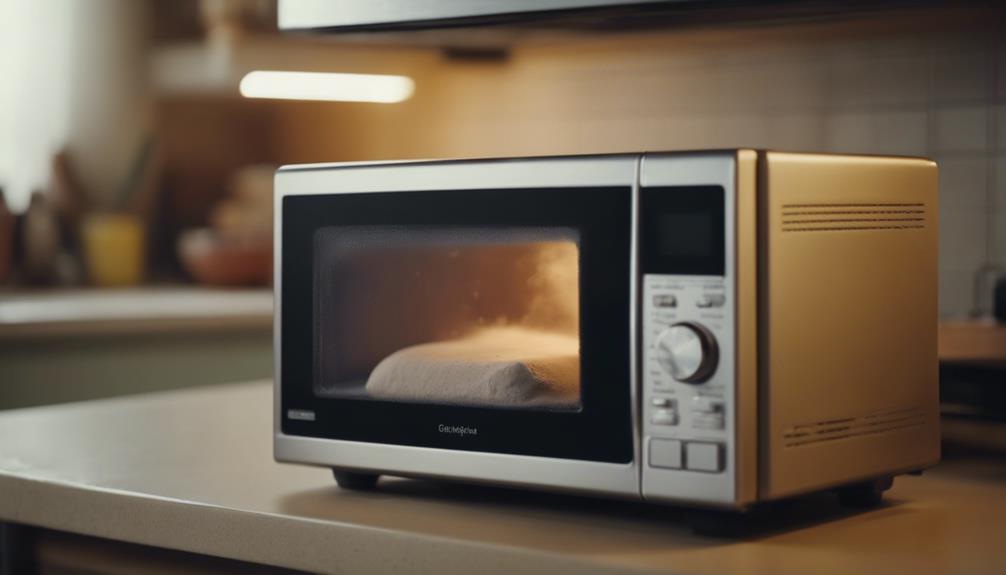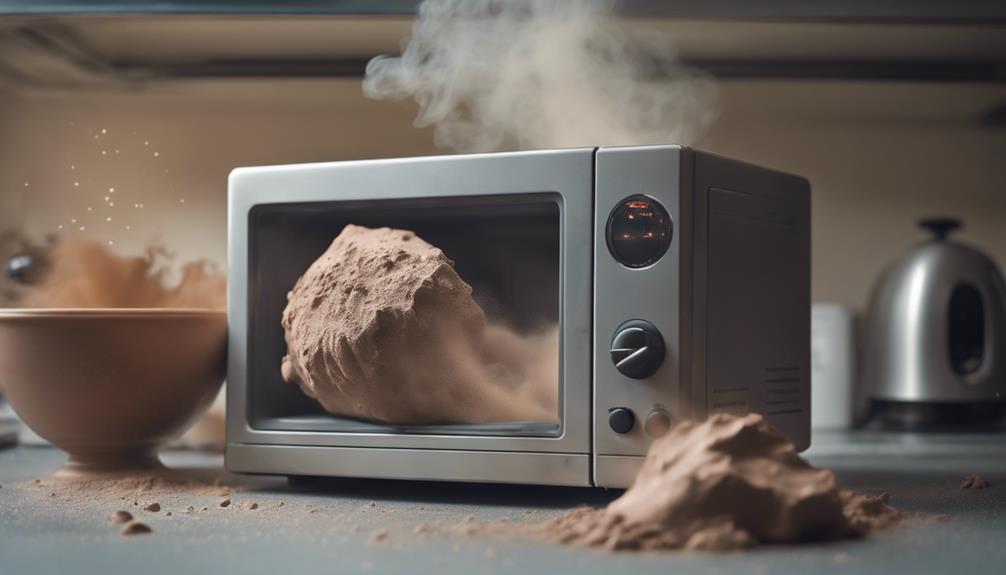Can You Microwave Clay
No, it is not safe to microwave clay.
Microwaving clay can lead to uneven curing, bubbling, and the release of harmful substances.
It is important to approach clay crafting with caution and explore alternative methods for efficient curing.
Key Takeaways
- Microwaving clay can lead to uneven curing and potential hazards.
- Oven baking offers uniform heating and control for safe curing.
- Consistency and safety are crucial in choosing clay heating methods.
- Following manufacturer guidelines ensures proper curing and desired results.
Safety Considerations for Microwaving Clay
When considering safety implications, it is crucial to understand the potential risks associated with microwaving clay for crafting purposes. Microwaving clay can lead to uneven curing, resulting in some parts being undercooked while others are burnt.
Overheating clay in the microwave can cause bubbling, burning, and the release of harmful chemicals. Clay with oil molecules may experience inconsistent heating in the microwave, affecting its final texture and quality.
To ensure safety and prevent potential hazards, it is best to avoid microwaving clay for crafting. For proper and controlled curing, it is recommended to bake polymer clay in a conventional oven following specific instructions provided by the manufacturer. This method helps maintain the integrity of the clay and prevents any risks associated with microwaving.
Effects of Microwaving Clay
Considering the potential hazards and risks associated with microwaving clay for crafting purposes, it is essential to understand the detrimental effects this method can have on the clay's consistency and quality.
When it comes to polymer clay, microwaving is particularly unsuitable due to the oil molecules present in its composition. These oil molecules do not heat evenly in the microwave, leading to issues such as uneven curing, bubbling, burning, and the potential release of harmful chemicals. The uneven heating can result in some parts of the clay curing while others remain soft, compromising the overall integrity of the piece.
To avoid these negative effects and ensure safe and consistent results, it is recommended to use an oven for baking polymer clay, providing uniform heating and better control over the curing process.
Pros and Cons of Microwaving Clay

When considering the pros and cons of microwaving clay, it is important to acknowledge that microwaving allows for quick heating, which can be beneficial for those seeking efficiency.
However, the risk of uneven heating poses a significant drawback, potentially leading to inconsistent curing and compromised final results.
Balancing the convenience of microwaving with the need for even heating is crucial in determining the suitability of this method for clay crafting projects.
Heating Clay Quickly
Heating clay quickly, such as through microwaving, can present both advantages and drawbacks that should be carefully weighed before choosing this method for crafting projects. When it comes to polymer clay, microwaving is not recommended due to safety concerns and unpredictable results.
Microwaving can lead to uneven heating, causing some parts to cure while others remain soft. Overheating polymer clay in the microwave may result in bubbling, burning, and the release of harmful chemicals.
In contrast, using an oven for baking clay offers more uniform heating and better control over the curing process. By following specific baking instructions tailored to different types of polymer clay, crafters can ensure proper curing and achieve successful crafting projects.
Risk of Uneven Heating
Crafters must be aware of the risk of uneven heating when microwaving clay, as this method can lead to inconsistent curing and potential hazards in the crafting process. When clay is not heated evenly, certain areas may cure while others remain soft, resulting in bubbling, burning, and the release of harmful chemicals from the clay. The oil molecules present in polymer clay make it particularly unsuitable for microwaving, further contributing to inconsistent curing. To ensure safe crafting and quality results, it is recommended to avoid microwaving clay altogether. Using ovens for baking polymer clay is preferable as they provide uniform heating and controlled environments, minimizing the risk of hazards associated with uneven heating.
| Cons of Microwaving Clay | ||
|---|---|---|
| Risk of uneven heating | Inconsistent curing | Potential hazards |
Tips for Microwaving Clay Safely
When microwaving clay, it's important to consider the types of clay suitable for this method. Follow the proper steps in the microwaving process and adhere to safety precautions to prevent overheating and potential hazards.
Understanding the specific clay types that can be microwaved, the correct process steps, and the safety measures to take will contribute to a successful and safe crafting experience with polymer clay. By focusing on these key points, crafters can achieve consistent and satisfactory results while avoiding risks associated with improper microwaving techniques.
Clay Types for Microwaving
For safe microwaving of clay, selecting high fire clays is recommended due to their durability and safety features. High fire clays are less porous compared to low fire clays, reducing the risk of potential issues in the microwave.
When choosing clays for microwaving, avoid those with high iron content as they can lead to overheating problems. Laguna is a reputable brand known for producing high fire clay suitable for microwaving. It is advisable to consult with clay dealers for specific recommendations on the best clay options for microwaving polymer clay.
Microwaving Process Steps
To ensure the safe and effective microwaving of clay, it is essential to follow specific steps that promote proper heating and curing of the material. Place the clay piece in a microwave-safe bowl and cover it with water to prevent overheating and burning. Microwave smaller clay pieces for about 2 minutes and larger pieces for 10 minutes or more based on weight. Boil water until the clay is baked properly, ensuring even curing. Allow the clay to cool adequately after microwaving to avoid damage and ensure proper hardening.
| Microwaving Process Steps | ||
|---|---|---|
| 1. Place clay in bowl | 2. Cover with water | 3. Microwave based on weight |
Safety Precautions for Clay
Implementing proper safety precautions when microwaving clay is crucial to prevent potential hazards and ensure a successful crafting experience. When it comes to baking polymer clay, it is recommended to avoid using the microwave due to the risk of uneven cooking and overheating.
Instead, opt for baking polymer clay in an oven for safe and effective curing. Ovens provide uniform heating, which is essential for even baking and proper curing of the clay pieces. To achieve the best results when curing polymer clay, always follow specific baking instructions and consider using an oven thermometer to monitor the temperature accurately.
Alternative Methods for Curing Clay
An alternative approach to curing clay involves exploring unconventional methods beyond the traditional oven-baking process. Convection ovens are a popular choice for curing polymer clay due to their ability to provide more even heating compared to microwaves.
Additionally, for smaller projects, using a heat gun or embossing tool can be a suitable alternative method. Some crafters opt to cure polymer clay in a dedicated toaster oven, which offers a controlled environment for the curing process.
Moreover, a few individuals have even experimented with solar curing techniques, harnessing the power of the sun to cure their clay creations. These alternative methods provide flexibility and options for artists seeking different ways to cure their polymer clay projects.
Final Verdict on Microwaving Clay

Microwaving clay for curing purposes is strongly discouraged due to the risks associated with uneven curing and potential hazards such as bubbling and the release of harmful chemicals. If you want to ensure the best results for your clay projects, it is recommended to bake clay in a conventional oven following specific instructions.
Here are four reasons why baking clay is the preferred method for curing:
- Uniform Curing: Baking clay in a conventional oven allows for even heating throughout, ensuring that the clay cures uniformly.
- Avoiding Hazards: By following the correct baking instructions, you can prevent bubbling, burning, and the release of harmful chemicals that may occur when microwaving clay.
- Manufacturer Recommendations: Manufacturers advise against microwaving clay due to safety concerns and the lack of control over the curing process.
- Desired Results: Following specific baking instructions for polymer clay is crucial to achieve the desired results in terms of texture, strength, and appearance.
Frequently Asked Questions
Can Microwaving Clay Cause It to Catch on Fire?
Safety precautions are essential when microwaving clay to prevent fire hazards. Overheating clay, especially with combustible additives, can lead to ignition. Follow recommended guidelines closely, monitor the process, and consider using conventional baking methods for polymer clay curing to avoid risks.
Will Microwaving Clay Affect the Color or Finish of the Final Product?
Microwaving clay can impact the color and finish of the final product due to uneven heating. To ensure color preservation and a smooth finish, traditional baking methods are recommended. Different clay types may react variably to microwaving, affecting outcomes.
Is It Safe to Microwave Clay if It Contains Metal or Other Additives?
When considering the safety of microwaving clay with metal or additives, it's crucial to address clay toxicity risks. Metal components can lead to sparking, uneven heating, and damage to both the clay and microwave, emphasizing the importance of careful examination before microwaving.
How Long Should I Microwave Clay for Optimal Results?
For optimal results when microwaving clay, it is essential to consider microwave safety. Follow guidelines based on the clay's weight, typically around 10 minutes per 100 grams. Proper curing ensures a thorough finish. Allow for adequate cooling post-microwaving.
Can I Reuse a Microwave That Has Been Used to Cure Clay for Food?
When considering microwave safety, it is advised against reusing a microwave that has been used to cure clay for food preparation. Residual clay particles and fumes can pose health risks if not properly cleaned and disinfected.
Conclusion
In the delicate art of crafting, using the right tools and techniques is crucial for success. Just as a skilled gardener carefully tends to their plants, a crafter must handle clay with precision and care.
Microwaving clay may seem like a quick fix, but it can lead to disastrous results. To ensure your creations blossom beautifully, it is best to follow recommended baking methods for a safe and satisfying crafting experience.
